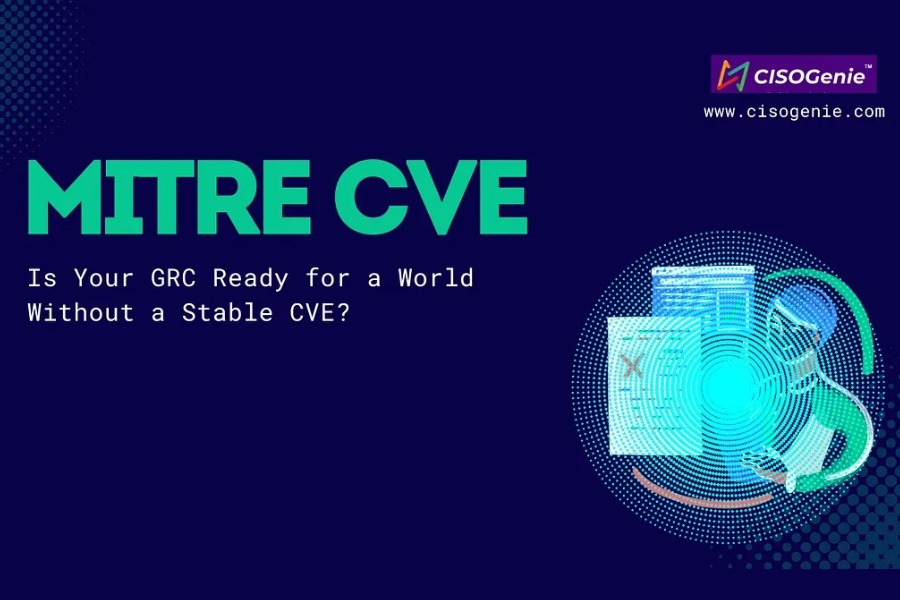A Close Call for the Cybersecurity Industry
Last week, the cybersecurity industry faced a huge risk/threat of its own — One that it barely scraped through at literally the 11th hour. MITRE’s CVE program’s funding contract was to expire on 15th April 2025 and no renewal discussions happened until late that night. Finally, CISA gave a lifeline by extending the funding contract by another 11 months, giving us all a reprieve.
Why the CVE Program Matters to Risk and Compliance
As a next generation GRC platform, CISOGenie fully understands the magnitude of risk we would have faced, had the program shutdown. In the cybersecurity industry, every product and solution that exists, can be broadly classified as a tool/product/solution for Risk handling (risk rating, prioritization, mitigation etc.), or a tool/product/solution for compliance adherence (Access Control, Privacy, Network protection, Endpoint protection etc.).
The CVE program played the most crucial role in the Risk aspects of cybersecurity. Be it for a GRC platform’s ability to assess, rate and prioritize a risk, or for a Vulnerability Manager to register, track and analyze a vulnerability, or an IDS/IPS solution to implement signations for a vulnerability, the CVE numbers, the CVE data and the patching information are all critical.
It is true that MITRE is not the only CVE Numbering Authority — But it was the central one. Though other CNAs could assign numbers, it would have taken weeks, if not months, to have had a coordinated numbering, communication and information dissemination in-place had MITRE’s CVE program ceases to exist. This is a huge risk, of a magnitude that some of us might not fully comprehend. It impacts everything from planned cybersecurity budgets and spends to product development and release cadence plans. Because, without coordinated information on vulnerabilities, Risk assessment, risk prioritization will slow down.
This impacts the mitigation plans and the budget required by an organization to implement that plan. To patch and fix vulnerabilities and to protect customers for being exploited, software vendors and cybersecurity vendors should act rapidly and make software releases — But without proper communication about CVEs that too will be a problem.
A Shutdown Would Have Disrupted Everything
The closure of the MITRE CVE program would have caused GRC platforms and solutions would have to
* Spend more time and effort ensuring the accuracy and completeness of vulnerability data.
* Develop expertise in navigating potentially multiple vulnerability tracking systems and data sources.
* Corelate data distributed across the Internet to arrive at CVE scoring
Finally, Vulnerability Management is a fundamental aspect of many crucial compliance standards and frameworks. And losing MITRE would have made all of us non-compliant, even if it would have been only for a few weeks. And this is not an acceptable state to be in.
The CVE Foundation:
The announcement by a few (yet anonymous) members of the MITRE CVE program about the formation of the CVE Foundation is a welcome move. The structure and operational process and policies of the foundation are yet to be seen. But at least, this is a step in the right direction.
What the Cybersecurity Community Needs to Do Now:
* Active Participation: Actively engage with the CVE Foundation through expertise, resources, advocacy, and governance dialogue participation, while also vigilantly observing its growth, principles, and activities.
* Independent sustenance: Make the entire process use an open and transparent approach — be in processes or tools. For e.g. Using a hosted Issue tracking system (while we could use something like GitHub, it adds a dependency on a corporate entity, in this case Microsoft). This way, even if funding is cancelled or even if an organization itself ceases to exist, the people behind it can keep it running, just like how members of the MITRE’s CVE program have come up with the CVE Foundation.
* Advocacy: Lobby for a diversified and resilient funding framework for CVE, with contributions from governments, industry partners, and international institutions. GRC solutions and platforms should advocate within their organizations for proactive engagement with the CVE Foundation to have a more distributed, resilient CVE management system.





